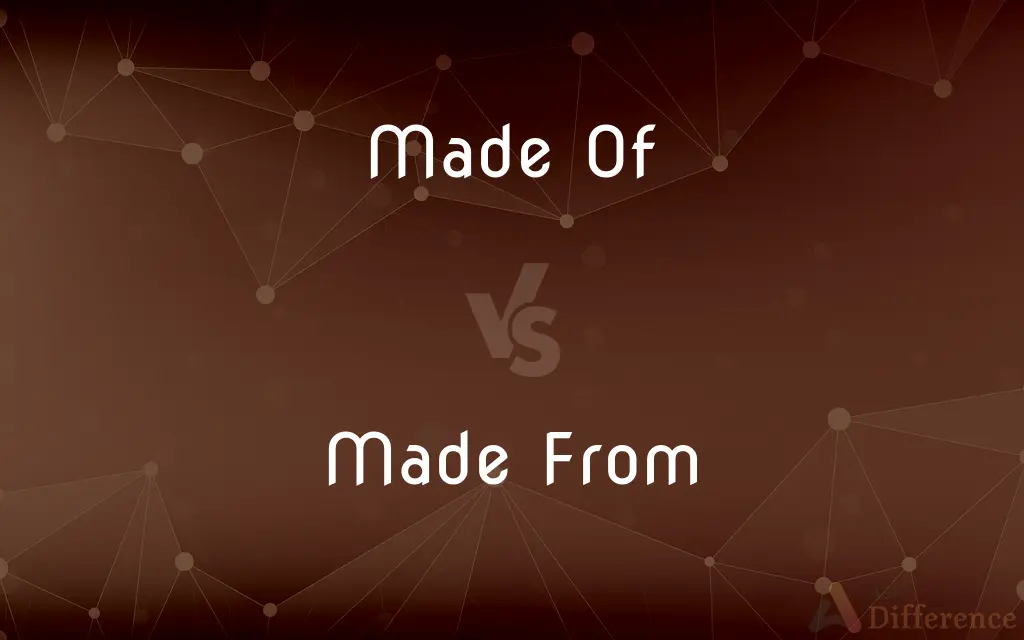Made Of vs. Made From — What's the Difference?
By Tayyaba Rehman & Fiza Rafique — Published on October 2, 2023
"Made of" indicates the original materials are still recognizable, while "made from" implies they've undergone a transformation.

Difference Between Made Of and Made From
Table of Contents
ADVERTISEMENT
Key Differences
"Made of" is commonly used when the original materials used in the object's creation can still be seen or identified. For instance, a wooden table is made of wood, and one can easily recognize that primary material.
On the contrary, "made from" is used when the materials have changed their nature or state in the process. An easy example to illustrate this point: paper is made from wood. Even though wood is the original material, the final product doesn't resemble wood at all.
Another distinguishing factor between "made of" and "made from" is the transformative process. "Made from" often implies a more in-depth transformation where the original state or essence of the materials is altered.
To further demonstrate, consider the scenario of a sculpture. A statue made of marble remains recognizably marble, while wine, made from grapes, doesn't retain the original appearance or essence of grapes.
Summing up, while both "made of" and "made from" describe origins, the former emphasizes the visible and consistent nature of the material, while the latter indicates a transformation of the original materials.
ADVERTISEMENT
Comparison Chart
Material Recognition
Original material is recognizable
Original material has transformed
Transformation
Little to no change in material's nature
Significant change in material's essence
Common Usage
Describing visible material
Describing transformed or processed material
Example
"shirt made of cotton"
"paper made from wood"
Nature of Items Described
Typically solid items
Typically items resulting from processing
Compare with Definitions
Made Of
Crafted using certain identifiable materials.
The artwork is made of beads and threads.
Made From
Created by altering the state or form of a substance.
Bread is made from flour.
Made Of
Constituted by particular components.
The salad is made of vegetables.
Made From
Formulated after processing certain ingredients.
The soap is made from natural oils.
Made Of
Designed with a visible substance.
The basket is made of wicker.
Made From
Produced by changing the basic essence of a material.
Wine is made from grapes.
Made Of
Built using a specific substance or element.
The necklace is made of gold.
Made From
Originated after undergoing a change.
Plastic is made from petroleum.
Made Of
Composed primarily of a certain material.
The chair is made of metal.
Made From
Crafted by transforming the original substance.
Cheese is made from milk.
Common Curiosities
Does "made from" always indicate a chemical change?
Not necessarily chemical, but a notable transformation from the original material.
Can an item be described using both "made of" and "made from"?
Yes, but the emphasis changes. A chair might be "made of wood" but "made from carved timber."
Can "made from" be used for mixtures?
Typically, no. Mixtures without transformation would use "made of," like "made of sugar and spice."
Is "made of" used for natural materials only?
No, it can be used for any material, as long as it remains recognizable.
Which term is more specific in nature?
"Made of" is more specific about the material's visibility, while "made from" emphasizes transformation.
Are "made of" and "made from" interchangeable?
Not always. They have different connotations based on the material's transformation or recognition.
Are there exceptions to these rules?
Language has nuances, so while these are general guidelines, exceptions may occur.
Can "made from" be used for artworks?
Yes, especially if the art material undergoes transformation, like clay figures fired in a kiln.
Can "made of" be used for composite materials?
Yes. For instance, "The material is made of plastic and metal fibers."
Is bread made of or made from flour?
Bread is "made from" flour since the flour undergoes transformation in the baking process.
Does "made from" imply a permanent transformation?
Generally, yes. Wine made from grapes cannot revert to grapes.
Can synthetic materials be described as "made of"?
Yes, if the resultant material remains recognizable.
Can "made from" describe an item's origins?
Yes, especially to emphasize transformation from the origin, like "rubber made from sap."
Is "made of" more commonly used than "made from"?
It depends on context, but "made of" is prevalent when material visibility is emphasized.
Is "made of" used for unprocessed materials?
Primarily, yes. For example, "a beam made of oak."
Share Your Discovery

Previous Comparison
Scarcity vs. Abundance
Next Comparison
Letter of Credit vs. Bank GuaranteeAuthor Spotlight
Written by
Tayyaba RehmanTayyaba Rehman is a distinguished writer, currently serving as a primary contributor to askdifference.com. As a researcher in semantics and etymology, Tayyaba's passion for the complexity of languages and their distinctions has found a perfect home on the platform. Tayyaba delves into the intricacies of language, distinguishing between commonly confused words and phrases, thereby providing clarity for readers worldwide.
Co-written by
Fiza RafiqueFiza Rafique is a skilled content writer at AskDifference.com, where she meticulously refines and enhances written pieces. Drawing from her vast editorial expertise, Fiza ensures clarity, accuracy, and precision in every article. Passionate about language, she continually seeks to elevate the quality of content for readers worldwide.
















































